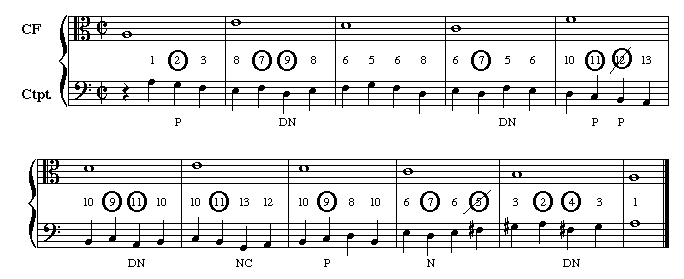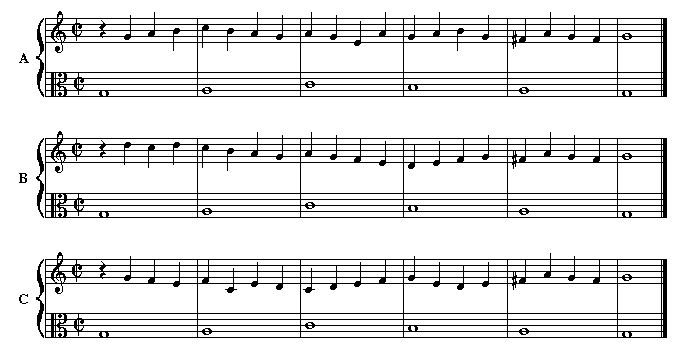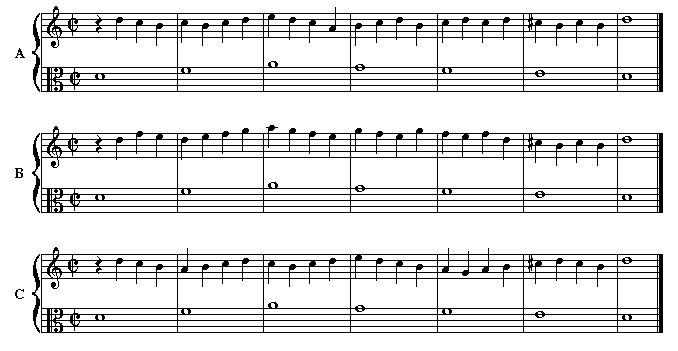SOUND PATTERNS
A Structural Examination of Tonality, Vocabulary, Texture,
Sonorities, and Time Organization in Western Art Music
by PHILLIP MAGNUSON

BASIC RULES FOR SPECIES COUNTERPOINT
Chapter 8. Species III in Two Voices
8.1 MELODIC PRINCIPLES FOR SPECIES III
-
The counterpoint moves four notes for every one
of the cantus firmus as in the example above.
-
The first note occurs on the "and" of beat 1; begin with a
quarter rest.
This is how Species III melodies will look at the beginning:

-
The last measure will be a whole note.
This is how Species III melodies will look at the end:

-
Conjunct motion is more important in this species than in the previous two;
do not leap more than once without changing direction.
The two successive leaps in measure 2 (both up) should not
be used in Species III.

-
Counterbalance leaps of a P4 and larger on both sides.
Examples of what you should (and should not) do.

-
Do not leap tritones, outline A4ths, or place A4ths on
successive strong beats.
Just as before, diaboli in musica are traditionally avoided.

-
The musica ficta may occur on the first, third, or fourth quarter note.
-
All other melodic principles are the same as for Species I and II.
IINTERLUDE 1
Which line below conforms to the principles of Species III?

8.2 CONTRAPUNTAL PRINCIPLES FOR SPECIES III
-
Beat 1 is always consonant.
-
Beat 2 may be either consonant or dissonant; if dissonant, it must be an accented passing tone.
These are examples of accented passing tones:

-
The second and fourth quarter notes (the "and" of beat 1 and 2) may also be dissonant; if so, they must be either passing tones, or neighbor tones (stepwise motion between two notes of the same pitch).
These are examples of passing tones and neighbor tones:

-
With the exception of the last measure, unisons may not occur on beat one; everyplace else they are acceptable.
INTERLUDE 2
Which counterpoint below is done correctly?

-
Parallel perfect consonances from the last quarter note in a measure to the next note must be avoided. In addition, the same perfect consonance must be avoided from beat 1 to the next beat 1 and from beat two to the next beat one.
The more notes you have, the more opportunities you have for parallels.

- Direct perfect consonances from the last quarter note in a measure to the next note must be avoided.
As with Species II, direct perfect consonances may not occur when both voices move, which is on beat 1.

- All other contrapuntal principles are the same as for Species I and II.
INTERLUDE 3
Which counterpoint below is done correctly?

8.3 MORE EMBELLISHMENTS FOR SPECIES III
- The Double Neighbor
Melodic: The double neighbor is a five note figure:
- Pattern 1: one step up, a 3rd down, two steps up
- Pattern 2: one step down, a 3rd up, two steps down
- Placement: must begin on beat 1

Contrapuntal:
- The first, fourth, and fifth quarter notes must be consonant
- The second and third quarter notes may be either consonant or dissonant

- The Nota Cambiata
Melodic: The nota cambiata ("changing note") is a five note figure:
- Pattern: must be one step down, a 3rd down, two steps up
- Placement: may begin on either beat 1 or beat 2

Contrapuntal:
- The first, third, and fifth quarter notes must be consonant
- The second and fourth quarter notes may be either consonant or dissonant

INTERLUDE 4
Which counterpoint below demonstrates the INCORRECT use of a double
neighbor or a nota cambiata?

8.4 EXAMPLE OF COUNTERPOINT IN SPECIES III

Notice how each dissonance is clearly labelled.
ASSIGNMENT:
SYNTHESIS
Using an assigned cantus firmus, write a soprano counterpoint
above, and a bass counterpoint below, in Species III.
This must be written as two separate pieces, one with a treble clef and alto clef, and a second with alto clef and bass clef. Follow the exact format of the example above, including the labels for the counterpoint and the cantus firmus.
Be careful to pay attention to all the principles of Species III. especially while writing a melodic line, and make sure that each dissonance is justified. Use at least one double neighbor and one nota cambiata in each exercise.
Cantus firmi
1. |  |
|---|
2. |  |
|---|
3. |  |
|---|
4. |  |
|---|
5. |  |
|---|
6. |  |
|---|
7. |  |
|---|
8. |  |
|---|
9. |  |
|---|
10. |  |
|---|
11. |  |
|---|
12. |  |
|---|
Links to chapters in this unit:
Link to previous unit: FUNDAMENTALS
Link to next unit: DIATONIC PROCEDURES I: Harmonic Dimensions
Copyright © 2008-2009 by Phillip Magnuson.
Content on this website is licensed under a Creative Commons License.





























